| dc.description.abstract | <p>The happening is a type of entertainment which was born in the United States and which is closely related to the avantgarde. In fact it attempts to extend the notion of theatre to every manifestation of life, as defined by one of its driving forces, John Cage. During the 1960s the happening became one of the most lively manifestations of the so-called underground culture in the U.S.A. The happening acquires its characteristics from the space within which it is enacted, from the juxtaposition of scenic moments, which according to Kirby substitute theatrical situations, and from the singular correlation which the intervention of the spectator establishes relative to the initial purpose and to whom it is explained. The happening claims not to go beyond the moment at which it takes place, although some experiments rising out of the happening are now considered to be classics. Today what is of most interest is to establish how far, and how, the happening of the decades immediately before the present one have influenced the new forms of theatre that are flourishing all around us.</p> | |


